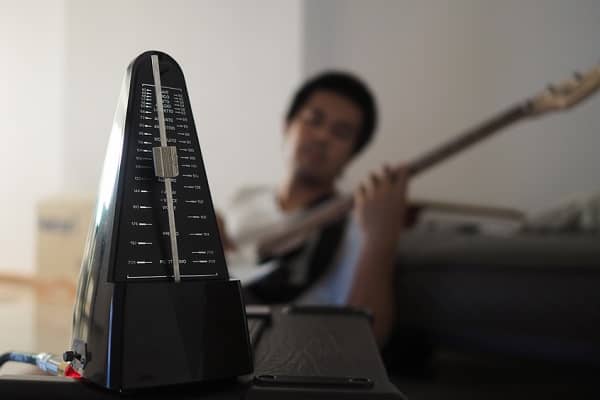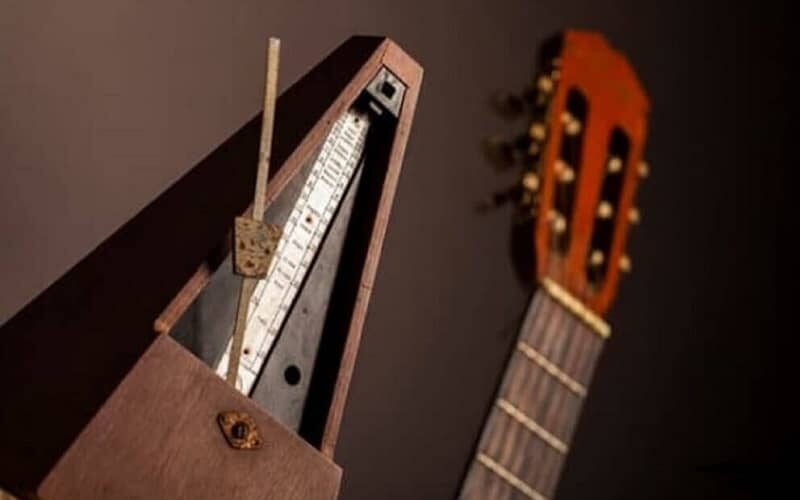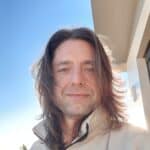Are you a beginner guitar player eager to take your guitar skills to the next level and elevate your timing and rhythm? If that’s the case, then it’s time for you to explore the incredible benefits of incorporating a metronome into your practice routine.
By harnessing the power of a metronome, you can revolutionize your guitar playing and unlock your true potential.
But before you dive into the world of practicing with a metronome, it’s crucial to have a solid understanding of its significance in the realm of the guitar. You might be wondering, “What is metronome in guitar?” or “What are metronomes used for?” and perhaps, “How to use metronome for guitar practice?”
In this article, we will delve deep into the world of metronomes and provide you with the best tips on how to practice with a metronome. So, let’s dive in and discover the transformative power of the metronome in your guitar journey.
What is a Metronome And How it Works?
A metronome is an indispensable tool for musicians, including those who play guitar. Whether it’s a traditional mechanical device, a modern electrical instrument, or an app on your smartphone or tablet, a metronome helps to maintain a steady tempo or constant speed during music practice sessions.
It provides an audible click or other repeated sounds at an adjustable pace, measured in beats per minute (BPM). For guitarists, incorporating a metronome into their practice routine is essential for honing their rhythm and timing skills.
When playing guitar, the metronome becomes a valuable companion during practice sessions. It assists in developing a precise sense of timing and improving overall musicality.
By setting the metronome’s tempo to an appropriate speed, guitarists can effectively practice rhythm patterns, chord progressions, and intricate guitar techniques. The metronome allows them to work on their playing accuracy and ensure consistent timing.
For instance, guitarists can practice playing quarter notes or eighth notes along with the metronome’s beat. By aligning their strumming or picking with the metronome clicks, they train themselves to play in sync with a consistent pulse.
This is particularly helpful when tackling challenging passages or complex rhythms. The metronome acts as a reliable guide, helping guitarists maintain a steady tempo even when confronted with intricate patterns.
Understanding how the metronome works is crucial. It functions by producing a regular interval of sound, typically accompanied by visual motion like a swinging pendulum or blinking lights.
This synchronization of auditory and visual cues reinforces the sense of timing, making it easier for guitarists to internalize and execute precise rhythmic patterns.
What is a Metronome Used for?

Everyone who has ever learned to play an instrument will know about the metronome. It’s one of the most used and common devices used for practicing, even today. While there may be some criticism surrounding its use by those who emphasize natural timing, the metronome remains a powerful ally for ear training.
Particularly in practicing guitar, the metronome plays a significant role in developing a strong sense of timing and the ability to stay on tempo. But it is not a necessary or a precondition to becoming a musician.
Practicing guitar with a metronome can assist you to evolve your internal clock and ensure precise timing. Though playing in time is a particularly vital skill and is especially demanding for musicians who are performing in a band or orchestral group, liable to set a tempo. Cause any type of band or orchestral group can’t produce music well without everyone using the same beat.
This is also helpful for the musicians who play in the studio and they are required to play accurately in time so that their music lines up completely with other tracks. So, you must be competent enough to play in time in different time signatures to play more complex music. Metronomes are also treated very significantly when you are looking to increase your speed as an instrumentalist.
Actually, the purpose of a metronome is to produce sounds that are all equally spaced out in time, ensuring that all the right notes are played with precision, allowing for a polished performance. But it’s invaluable to guitar players or pianists if you know how to use it right.
To fully harness the benefits of the metronome, incorporating specific guitar timing exercises and guitar metronome exercises into your practice sessions can yield great results. Gradually increasing the metronome speed challenges your abilities and pushes you to improve.
With time, you’ll find that your guitar technique becomes more solid and your ability to maintain appropriate tempo becomes second nature.
How to Use a Metronome for Practice Guitar?
If you are struggling to practice your guitar techniques and don’t know where to start with this handy little device or how to play guitar with a metronome, here are 9 of the best metronome practice techniques for you to try.
1. Play with the Beat
Playing along with the beat of a metronome means you will be playing precisely together with the sounds it produces. How do you know you are on time with the metronome? You’ll stop hearing that click, of course. Being able to play along with the beat of the metronome is a real skill that can take a lot of practice.
There are, of course, different sides to the beat as well (the back, center, and top). This tip is only meant for when you are practicing. You don’t need to restrict all of your guitar playings to sound like a metronome.
2. Learn to Internalize the Beat
The number one purpose for using a metronome is to get that feeling for a consistent beat. Beat and tempo are something that can be learned, so if you don’t think you have a strong inner rhythm, it’s time to whip out the metronome. If you want to learn better rhythm, take the time away from your guitar with your metronome.
Try this technique at the beginning of your practice sessions:
- Set your metronome to a steady beat that is easy for you to follow.
- Sit and listen to the beat until you get a good feel for it.
- When you have the beat down, start moving to it by clapping your hands or tapping your foot.
The more practice you have using this method, the more a beat will come naturally to you in the future. It will also allow you to play along with a metronome much more accurately.
3. Practicing with a Metronome for Tempo Speeds

A common misconception when practicing your guitar is that you should go in at full tempo right from the start. The fact is that even professional musicians spend a lot of their practice time playing a piece at a slower tempo.
If you feel like your music is at a tempo that feels unachievable, the metronome can step right in to help. Let’s use an example to illustrate this point:
- If you have a piece of music that has a 120 BPM temp, try setting your metronome for 60 BPM.
- Stay at this speed until you feel completely comfortable and can play the piece accurately.
- Once you have reached a level of comfort, bump the BPM up in 2-4 beat increments each time.
- Don’t go over 4 BPM as this will be too much of an increase.
- Stay at the new, ever so slightly increased tempo until you are completely confident.
The reason this method works so well is that you barely notice the slight increases, but over time you can play at a faster pace with complete precision. It will probably take you quite a few sessions of practice to nail that final tempo, but it’s definitely a solid approach that could help you out massively.
4. Subdivide the Difficult Rhythms When Practicing with a Metronome
Many of our guitar riffs feature tricky rhythms that can be really hard to play. But of course, our trusty friend the metronome can help you out if you are having trouble staying on the beat. You do this by subdividing the beats down into smaller units.
Let’s go with another example to demonstrate how to do this. If you were having a rough time trying to line up quarter notes to a 60 BPM rhythm, set your metronome to 120 BPM. You will feel the eighth note in the pulse.
So how is this approach helpful for guitar players? Slower beats are very difficult to internalize but doubling up the beat and playing a smaller unit of notes makes it much more doable.
5. Practice Your Coordination Skills
With the guitar, you are thinking about multiple things at a time, so coordination is key to playing well. To simplify the amount you have to think about, why not use the metronome?
Focusing on the rhythm will stop you from worrying about technique and pitch as you play. You can even tap or clap along with the metronome as if you were playing the notes.
Coordinating the timing of your hands to the timing of the metronome brings everything into place, so that when you return to your instrument, you have a better grasp on your piece.
6. Practicing With a Metronome for Exercises and Scales
Has there ever been anyone that loves scales and exercises when practicing their instrument? Probably not, but every pro guitar player will tell you how important they are for your musical development. Because scales and exercises are the boring part of playing, it can be very tempting just to rush through.
But it’s important to take your time and even practice them with your metronome to help your skills develop. How does practicing scales and guitar exercises with metronome help? It will help you maintain a much more clear and consistent tone throughout your playing.
Plus, there’s that extra time to get the feeling of the rhythm if you find your sense of tempo is off. As you progress through your exercises using your metronome, you may find that more complex pieces become a lot easier.
7. Experiment with Different Time Signatures

Experimenting with different time signatures while using a metronome opens up a world of rhythmic possibilities for guitarists. While a 4/4 time signature is commonly used in many songs, venturing into time signatures like 3/4, 6/8, or even more complex ones like 7/8 can greatly enhance your sense of timing and adaptability.
When exploring different time signatures, start by setting your metronome to a slow tempo, allowing you to grasp the rhythmic structure more easily. Digital metronomes offer the flexibility to select specific time signatures, making it convenient to switch between different rhythmic patterns.
As you play along, pay attention to the metronome’s click on the first beat of each measure and how it divides the remaining beats. This will help you internalize the unique rhythmic feel of each time signature.
8. Use the Metronome in Creative Ways
Don’t confine your metronome practice solely to scales and exercises; instead, explore its creative potential. Use the metronome to experiment with rhythmic patterns, accompany your favorite songs, and delve into different genres and musical styles.
By incorporating these creative elements, you’ll challenge yourself and keep your practice sessions engaging and enjoyable.
9. Focus on Accuracy, Clean Execution and Analyze Your Progress
During your metronome practice sessions, prioritize accuracy and clean execution of your techniques. Pay close attention to every note, ensuring that each one aligns perfectly with the metronome’s beat. This emphasis on precision will help you develop better control over your playing and eliminate any sloppy habits.
In addition, record your practice sessions with the metronome and take the time to critically listen back to them. Look for any timing inconsistencies or areas where you struggled to keep up with the beat. This self-analysis will help you identify specific areas for improvement and track your progress over time.
As you gain confidence and proficiency in playing with the metronome, challenge yourself by gradually reducing its volume or turning it off for certain sections.
By gradually weaning yourself off the metronome, you will become more prepared for playing without it in live performances, jam sessions, or collaborations with other musicians.
Frequently Asked Questions
What is a metronome exercise?
A metronome exercise is a practice technique that involves using a metronome to maintain a consistent tempo while playing guitar. It helps improve timing, rhythm, and precision.
The exercise typically involves playing scales, chords, or musical passages in sync with the metronome’s beats, gradually increasing the tempo to enhance speed and accuracy.
Should a beginner guitarist use a metronome?
Yes, a beginner guitarist should use a metronome. It helps develop a strong sense of timing, rhythm, and coordination from the start. Practicing with a metronome helps beginners learn to play in tempo, improves accuracy, and builds a solid foundation for musical growth.
What is the metronome speed for a beginner guitar?
The metronome speed for a beginner guitarist varies depending on the individual’s skill level and comfort. It is recommended to start with a slower tempo, around 60-80 beats per minute (BPM), and gradually increase the speed as proficiency improves. It’s important to find a pace that allows for accurate playing and gradual progress.
Final Words
If playing along and doing your guitar practice with a metronome is something you haven’t tried out in the past, it should definitely go on your to-do list. It’s not something that is easy to do at first, but consistent practice will see you reaping the benefits in no time.
Also, remember that a metronome isn’t vital for the entire time you practice. Try to use it for smaller sections of music or to accomplish specific skills you want to master.
Using it in this way means that your playing won’t become mechanical, and you won’t become bored with the metronome either.
About the Author
Fabian, a Brazilian guitarist now based in Dublin, Ireland, has passionately played the electric guitar since 2003. As a luthier and product specialist, he boasts nearly two decades of collaboration with top musical instrument brands. Fabian is a sought-after expert, sharing his extensive knowledge with fellow guitar enthusiasts.


